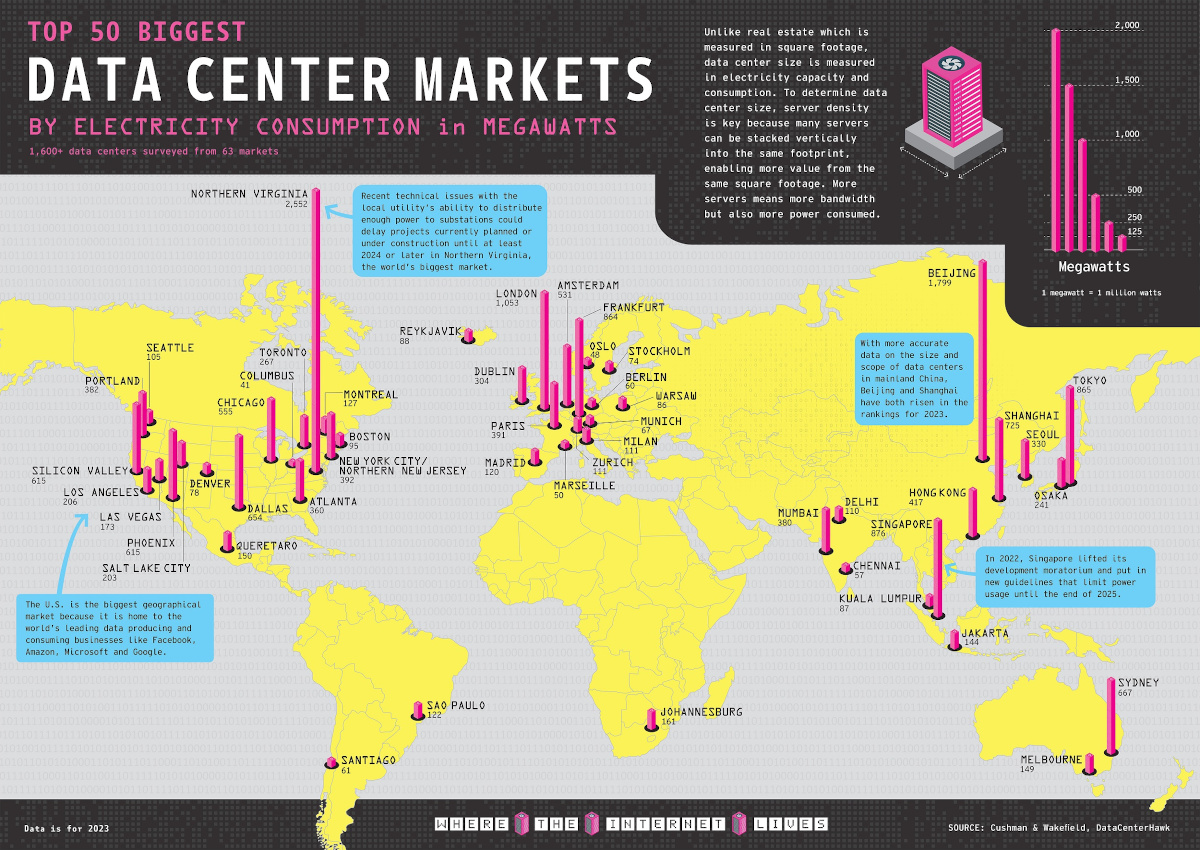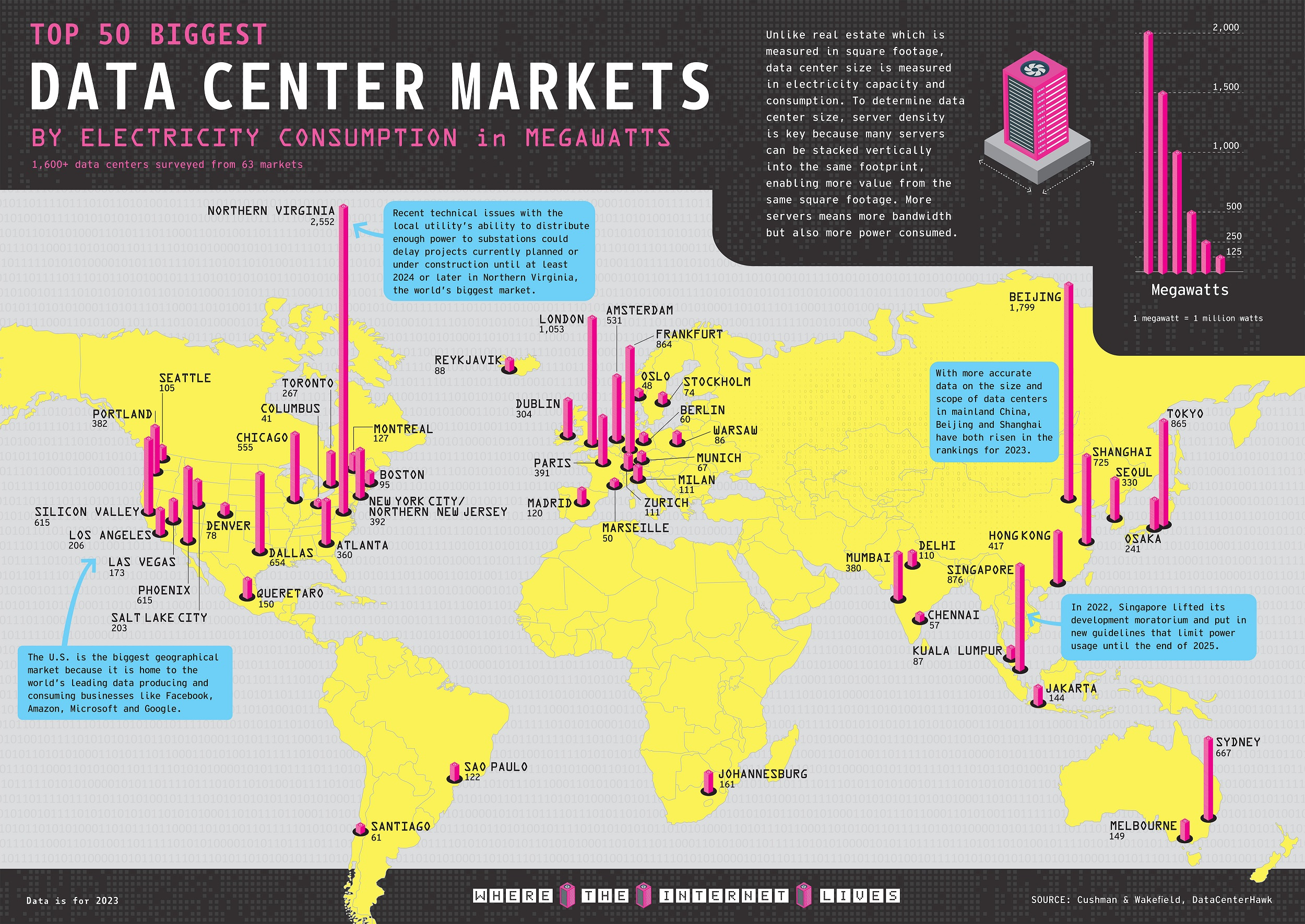Technology
Ranked: Top 50 Data Center Markets by Power Consumption
Click to view this graphic in a higher-resolution.
Top 50 Data Center Markets by Power Consumption
We live in an information-abundant digital world, where data is the new currency, and data centers are the vaults that protect and power it.
The amount of data created each year has skyrocketed from 2 zettabytes in 2010 to 44 zettabytes (44 trillion gigabytes) in 2020. This has surged demand for data storage and processing, leading to the construction of massive data centers around the world.
So, where are the biggest data centers?
In this graphic, Julie Peasley uses 2023 data from Cushman & Wakefield to shed light on the biggest data center markets.
The Biggest Data Center Markets
Today, it is estimated that there are over 8,000 data centers in the world.
Many of these centers end up clustered together due to beneficial infrastructure and provisions from local governments and utilities. They also need lots of power, often at least 100 MW for each center, making power consumption one of the best ways to measure total market size.
While a majority of these data center markets are in the United States, some of them are scattered across Asia and Europe.
| Rank | Data Center Market | Country | Capacity (MW) |
|---|---|---|---|
| 1 | Northern Virginia | 🇺🇸 United States | 2,552 |
| 2 | Beijing | 🇨🇳 China | 1,799 |
| 3 | London | 🇬🇧 United Kingdom | 1,053 |
| 4 | Singapore | 🇸🇬 Singapore | 876 |
| 5 | Tokyo | 🇯🇵 Japan | 865 |
| 6 | Frankfurt | 🇩🇪 Germany | 864 |
| 7 | Shanghai | 🇨🇳 China | 725 |
| 8 | Sydney | 🇦🇺 Australia | 667 |
| 9 | Dallas | 🇺🇸 United States | 654 |
| 10 | Silicon Valley | 🇺🇸 United States | 615 |
| 11 | Phoenix | 🇺🇸 United States | 615 |
| 12 | Chicago | 🇺🇸 United States | 555 |
| 13 | Amsterdam | 🇳🇱 Netherlands | 531 |
| 14 | Hong Kong | 🇭🇰 Hong Kong | 417 |
| 15 | New York City - Northern New Jersey | 🇺🇸 United States | 392 |
| 16 | Paris | 🇫🇷 France | 391 |
| 17 | Portland | 🇺🇸 United States | 382 |
| 18 | Mumbai | 🇮🇳 India | 380 |
| 19 | Atlanta | 🇺🇸 United States | 360 |
| 20 | Seoul | 🇰🇷 South Korea | 330 |
| 21 | Dublin | 🇮🇪 Ireland | 304 |
| 22 | Toronto | 🇨🇦 Canada | 267 |
| 23 | Osaka | 🇯🇵 Japan | 241 |
| 24 | Los Angeles | 🇺🇸 United States | 206 |
| 25 | Salt Lake City | 🇺🇸 United States | 203 |
| 26 | Las Vegas | 🇺🇸 United States | 173 |
| 27 | Johannesburg | 🇿🇦 South Africa | 161 |
| 28 | Querétaro | 🇲🇽 Mexico | 150 |
| 29 | Melbourne | 🇦🇺 Australia | 149 |
| 30 | Jakarta | 🇮🇩 Indonesia | 144 |
| 31 | Montreal | 🇨🇦 Canada | 127 |
| 32 | São Paulo | 🇧🇷 Brazil | 122 |
| 33 | Madrid | 🇪🇸 Spain | 120 |
| 34 | Milan | 🇮🇹 Italy | 111 |
| 35 | Zurich | 🇨🇭 Switzerland | 111 |
| 36 | Delhi | 🇮🇳 India | 110 |
| 37 | Seattle | 🇺🇸 United States | 105 |
| 38 | Boston | 🇺🇸 United States | 95 |
| 39 | Reykjavík | 🇮🇸 Iceland | 88 |
| 40 | Kuala Lumpur | 🇲🇾 Malaysia | 87 |
| 41 | Warsaw | 🇵🇱 Poland | 86 |
| 42 | Denver | 🇺🇸 United States | 78 |
| 43 | Stockholm | 🇸🇪 Sweden | 74 |
| 44 | Munich | 🇩🇪 Germany | 67 |
| 45 | Santiago | 🇨🇱 Chile | 61 |
| 46 | Berlin | 🇩🇪 Germany | 60 |
| 47 | Chennai | 🇮🇳 India | 57 |
| 48 | Marseille | 🇫🇷 France | 50 |
| 49 | Oslo | 🇳🇴 Norway | 48 |
| 50 | Columbus | 🇺🇸 United States | 41 |
With nearly 300 data centers, including many AWS servers, the Northern Virginia data center market is the largest in the world. Data centers in the region are estimated to handle more than one-third of global online traffic.
In 2023, Northern Virginia data centers had a combined power consumption capacity of 2,552 MW. That’s four times the capacity of the next closest American markets, Dallas (654 MW) and Silicon Valley (615 MW).
The second-biggest market, Beijing, has a measured capacity of 1,799 MW. Though it is currently the only market with an operational capacity of over 1,000 MW in the Asia Pacific Region, Tokyo (865 MW) appears to be catching up fast.
Europe’s biggest data center clusters are in London (1,053 MW) and Frankfurt (864 MW), largely due to demand from large local enterprises and organizations. It’s no coincidence that they are major hubs for government and commerce—the world’s largest data center markets are near capital cities, as historically, governments (and their militaries) were the first to invest in internet infrastructure.
Future of Data
Data centers will continue growing in scale and expanding into new markets to meet the demands of digitalization.
Already the wider adoption of artificial intelligence has changed where internet data is flowing. And with increasing digital demands, the amount of energy needed to power these centers also increases.
That has increasingly put the spotlight not just on companies and data center markets, but on the energy they’re using. With massive power consumption requirements, efficiency and sustainability become increasingly important, and not every market is prioritizing efficient sources of electricity.

This article was published as a part of Visual Capitalist's Creator Program, which features data-driven visuals from some of our favorite Creators around the world.
Technology
All of the Grants Given by the U.S. CHIPS Act
Intel, TSMC, and more have received billions in subsidies from the U.S. CHIPS Act in 2024.

All of the Grants Given by the U.S. CHIPS Act
This was originally posted on our Voronoi app. Download the app for free on iOS or Android and discover incredible data-driven charts from a variety of trusted sources.
This visualization shows which companies are receiving grants from the U.S. CHIPS Act, as of April 25, 2024. The CHIPS Act is a federal statute signed into law by President Joe Biden that authorizes $280 billion in new funding to boost domestic research and manufacturing of semiconductors.
The grant amounts visualized in this graphic are intended to accelerate the production of semiconductor fabrication plants (fabs) across the United States.
Data and Company Highlights
The figures we used to create this graphic were collected from a variety of public news sources. The Semiconductor Industry Association (SIA) also maintains a tracker for CHIPS Act recipients, though at the time of writing it does not have the latest details for Micron.
| Company | Federal Grant Amount | Anticipated Investment From Company |
|---|---|---|
| 🇺🇸 Intel | $8,500,000,000 | $100,000,000,000 |
| 🇹🇼 TSMC | $6,600,000,000 | $65,000,000,000 |
| 🇰🇷 Samsung | $6,400,000,000 | $45,000,000,000 |
| 🇺🇸 Micron | $6,100,000,000 | $50,000,000,000 |
| 🇺🇸 GlobalFoundries | $1,500,000,000 | $12,000,000,000 |
| 🇺🇸 Microchip | $162,000,000 | N/A |
| 🇬🇧 BAE Systems | $35,000,000 | N/A |
BAE Systems was not included in the graphic due to size limitations
Intel’s Massive Plans
Intel is receiving the largest share of the pie, with $8.5 billion in grants (plus an additional $11 billion in government loans). This grant accounts for 22% of the CHIPS Act’s total subsidies for chip production.
From Intel’s side, the company is expected to invest $100 billion to construct new fabs in Arizona and Ohio, while modernizing and/or expanding existing fabs in Oregon and New Mexico. Intel could also claim another $25 billion in credits through the U.S. Treasury Department’s Investment Tax Credit.
TSMC Expands its U.S. Presence
TSMC, the world’s largest semiconductor foundry company, is receiving a hefty $6.6 billion to construct a new chip plant with three fabs in Arizona. The Taiwanese chipmaker is expected to invest $65 billion into the project.
The plant’s first fab will be up and running in the first half of 2025, leveraging 4 nm (nanometer) technology. According to TrendForce, the other fabs will produce chips on more advanced 3 nm and 2 nm processes.
The Latest Grant Goes to Micron
Micron, the only U.S.-based manufacturer of memory chips, is set to receive $6.1 billion in grants to support its plans of investing $50 billion through 2030. This investment will be used to construct new fabs in Idaho and New York.
-

 Debt1 week ago
Debt1 week agoHow Debt-to-GDP Ratios Have Changed Since 2000
-

 Markets2 weeks ago
Markets2 weeks agoRanked: The World’s Top Flight Routes, by Revenue
-

 Countries2 weeks ago
Countries2 weeks agoPopulation Projections: The World’s 6 Largest Countries in 2075
-

 Markets2 weeks ago
Markets2 weeks agoThe Top 10 States by Real GDP Growth in 2023
-

 Demographics2 weeks ago
Demographics2 weeks agoThe Smallest Gender Wage Gaps in OECD Countries
-

 United States2 weeks ago
United States2 weeks agoWhere U.S. Inflation Hit the Hardest in March 2024
-

 Green2 weeks ago
Green2 weeks agoTop Countries By Forest Growth Since 2001
-

 United States2 weeks ago
United States2 weeks agoRanked: The Largest U.S. Corporations by Number of Employees
















